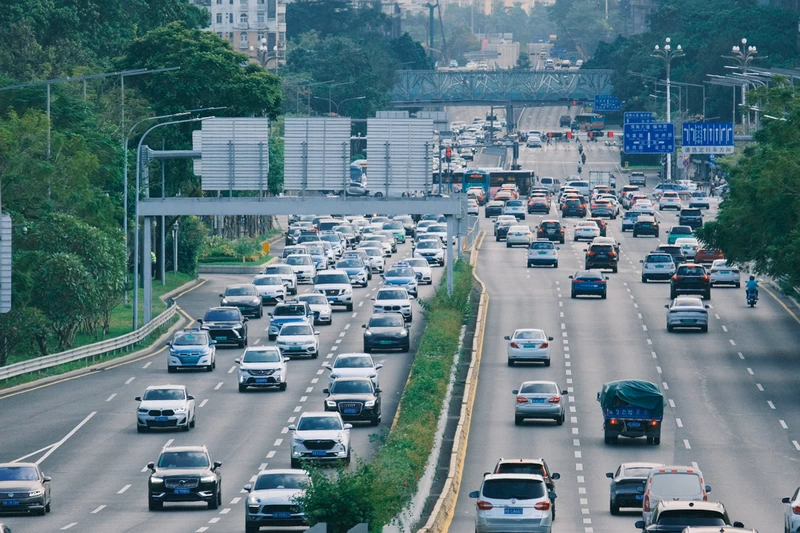At first glance, driving in China might seem a lot like driving in the United States. The highways are wide and modern, road signs often include both Chinese and English, and the streets are filled with familiar vehicles. But don’t be fooled—this surface-level similarity can be misleading.
Beneath that familiarity lies a completely different driving culture shaped by unique traffic patterns, local habits, and massive holiday migration. For example, during major holidays like Chinese New Year, the roads can become gridlocked with hundreds of millions of travelers—one traffic jam famously lasted over a week!
That’s why it’s essential to understand the 3 Things American Drivers Need to Know Before Driving In China. Whether you’re planning to rent a car, drive for work, or explore off-the-beaten-path destinations, these tips will help you avoid surprises and stay safe behind the wheel.
#1. Traffic Rules Exist… But They’re Interpreted Differently
In the United States, traffic laws are strictly followed and generally respected by other drivers. While exceptions exist, there’s a widely shared understanding that if a sign says “Stop,” you stop. If you’re turning left, you wait your turn. In China, however, rules may be written, but the enforcement and adherence to them can sometimes vary wildly from one intersection to the next.
You’ll also see a lot of EVs and self-driving cars on the streets, which is something you’ll also need to get used to. In fact, in 2025, the country is expected to see 15 million EVs with this self-driving tech. However, Beijing already has to walk a tight line here after accidents have caused scrutiny on autonomous vehicles. Moreover, with the somewhat prevalent reckless driving, even the best AI drivers are going to make mistakes.
It’s common for vehicles to weave between lanes, for scooters and bicycles to ride against traffic, and for honking to replace indicators as a form of communication. Even traffic lights can sometimes feel more like starting-line countdowns in larger cities.
Such behavior might be incredibly rare to see in the United States, even in big cities like New York or Atlanta. So, despite how you’ll hear that Atlanta ranks as one of the worst cities to drive, it’s a completely different situation across the ocean. Some of the driving you’ll see in China would give an Atlanta car accident lawyer nightmares, but you’ll have to get used to it quickly.
Moreover, if you get into an accident, your usual checklist of things to do won’t carry over as well. To give you an idea, TorHoerman Law typically suggests collecting photographic evidence. While there are no specific rules against that in China, it can escalate a tense situation, especially if you’re an obvious foreigner.
So, be mindful of the cultural context and know that even if you drive by the book, things may go differently here.
#2. Your American Insurance Likely Won’t Carry Over
Let’s face it: nobody likes thinking about worst-case scenarios while traveling. But if you’re planning to drive in a foreign country, especially one as logistically and legally different as China, ignoring this aspect is a risk you really can’t afford to take. You
In the U.S., you’re likely familiar with car insurance policies and what they cover. You might even have roadside assistance, personal injury protection, and a go-to contact in case things go south. But in China, the system works differently.
For starters, many American insurance policies don’t cover international rentals, and even travel insurance may only offer minimal protection unless you specifically add on car-related coverage.
On top of that, accident liability laws in China can be complex, especially for foreigners. If you’re involved in a collision, there may be language barriers, unclear fault determination, and a process that requires you to navigate both legal and cultural nuances.
In some cases, locals may assume the foreigner is at fault by default. Add to that the challenge of dealing with rental companies and local police, and you’ll understand why preparation is so important.
So, you essentially have to get insurance from Chinese insurers. Thankfully, this isn’t as hard as it used to be. Last year, Taiping Life Insurance put effort into improving services to foreigners by upgrading hardware at 1,252 franchises. By May, over 252 insurance policies were purchased by foreign clients. This is good news to hear, regardless of other challenges.
#3. Start Mentally Preparing Yourself for the Stress
Driving in China isn’t just about dealing with different traffic patterns, it’s about managing your mindset in an environment that’s high-pressure and emotionally charged. The sheer unpredictability on the road can be overwhelming. As we touched on earlier, cars squeeze into tight spaces without warning, scooters appear out of nowhere, and intersections can feel like a free-for-all.
It’s chaotic, and this is something that’s even been researched. A study by Sun, Jiang, et. al. on two groups of drivers, 215 from China and 240 from the U.K., confirms this. The researchers found that Chinese drivers exhibited higher levels of reckless, angry, and anxious driving.
Honestly, this is not surprising when you experience how dense and fast-paced the traffic can get, especially in major cities like Shanghai or Guangzhou.
If you’re not mentally prepared, the constant honking, last-minute lane shifts, and the pressure to keep up can easily spike your stress levels. It’s very easy to go from calm to on edge in just a few minutes. That’s why, when driving in China, emotional regulation is just as important as navigation.
Instead of bracing for confrontation or trying to enforce logic onto the chaos, your best bet is to stay calm, observant, and fluid. Driving here is less about control and more about adaptability, both mentally and emotionally.
Frequently Asked Questions
1. Can tourists drive in China?
Tourists can’t drive in China with just an international license. You’ll need a temporary Chinese driving permit, which you can usually get if you already have a valid license from your home country.
2. How safe is driving in China?
Driving in China can be safe if you’re alert, but it’s a very different vibe from the U.S. or Europe. Expect unpredictable moves, lots of honking, and less strict rule-following, especially in busy cities. It’s doable, just stay sharp.
3. What is the speed limit in China?
Speed limits vary depending on the road. On highways, it’s usually 120 km/h (about 75 mph), while city roads are around 60 km/h (37 mph). Always watch for signs, though, as limits can change quickly, and cameras are everywhere.
All things considered, driving in China as an American will certainly require you to recalibrate your expectations. However, spend some time on the streets, and you’ll see that what seems reckless at first is actually part of a very different but functional system. Of course, if all else fails, you can simply rely on public transport, which is robust and well-established in all the urban areas.
Driving in China can be an incredible way to explore the country’s diverse landscapes and vibrant cities—but only if you’re properly prepared. By keeping these 3 Things American Drivers Need to Know Before Driving In China in mind, you’ll not only stay safe and legal on the road, but also enjoy a smoother, more confident driving experience. Whether you’re navigating Beijing’s bustling streets or cruising through the scenic countryside, knowing the rules and expectations ahead of time makes all the difference. Drive smart, stay alert, and embrace the adventure!



